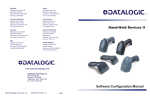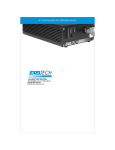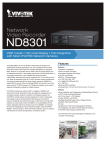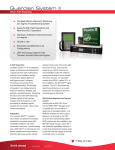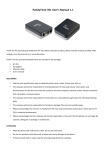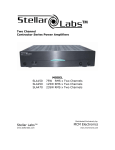Download Tamper Detect Installation Instructions
Transcript
AMR-960 Installation Instructions Sensus Tamper Detect Module 2. Install MIU at selected location and wire to encoder and phone line according to MIU installation instructions. (Sensus installation bulletin AMR-971R1) Introduction The Tamper Detect Module was designed for use with the Sensus PhonRead system Meter Interface Unit (MIU) to indicate that possible tampering had occurred at the meter location. The “latch” feature of the module immediately locks into a tamper detect position until reset at the location by authorized utility personnel. The Tamper Detect Module has four colored wires, R=Red, B=Black, G=Green, and Y=Yellow. These will be used to install the Tamper Detect Module to the MIU. R 3. It is recommended that the Tamper Detect Module be adhered to the electronics cover plate inside the PhonRead MIU. This can be done by removing the backing of the double stick adhesive on the back of the Tamper Detect Module and pressing firmly onto the MIU electronics cover plate. Be sure to mount module on the cover plate close enough so that the red (R), green (G), and black (B) wires coming from the module can be connected to the proper MIU port. The proper port is the one that will be programmed by the MIU Programmer for use with “Tamper Module.” This is usually Port 2 of the MIU. See diagram A. diagram A Yellow The following Tamper Detect Module installaBlack tion instructions provide Green for the minimum requireRed ments for a successful installation. This installation instruction document is only for installation of the Tamper Detect Module. For instructions on installing other AMR devices, please request and refer to the individual installation instructions for those devices. Tamper Detect Module Installation Tools and Materials Electronics Cover Plate ● Screwdriver – Small standard head for terminal screws ● Wire cutter and stripper ● Wire stapler ● 2-conductor solid wire for Tamper Latch Module wiring only (Sensus spec) ● 5-conductor wire minimum for combined Tamper Latch Module wiring and absolute encoder wiring – Sensus spec (Optional) ● Plastic coated (jacketed) seal wire ● 3M UY-2 gel-cap wire connectors ● MIU Programmer, module and cable (Sensus 4000 HHD) 4. Next, connect the wires (RED, GREEN, BLACK) from the Tamper Detect Module) to the appropriate port of the MIU. Prior to connecting the wires to the terminals of the MIU, the wire jacket should be stripped approximately 1/4" at end, exposing bare wire for each of the colored wires. Be sure to match the wire colors from the Tamper Detect Module to the proper terminals of the MIU port – RED to “R”, GREEN to “G”, and BLACK to “B”. Insert bare wire end into appropriate wire location and tighten terminal screw to secure wire connection to the terminal block. Check each connection by pulling wire gently. See diagram B. ● MIU Programming software diagram B Installation Instructions 1. Based upon the MIU installation instructions, the following recommended installation guidelines should be considered for an actual MIU installation: a. Placement which is accessible to both utility meter and intended customer’s telephone line access – and the telephone line is working b. Recommend inside installation (outside permitted) away from excessive amounts of heat and moisture. (Pit installations not recommended.) Yellow Red Green Black c. Consider convenience of homeowner d. Room for installation and future access e. Consideration for optional TouchRead TouchPad installation if being used Page 1 of 4 AMR-960 Installation Instructions Sensus Tamper Detect Module 5. All that remains to be connected is the YELLOW “Y” wire. This wire is used to create a continuity loop to where the tamper detect is desired to be installed. This is usually a meter location. If the MIU is located near the meter installation, a single plastic coated seal wire can be used to create the continuity loop with the Tamper Detect Module. b. Connect one end of the two-conductor wire or one of the pair of wires of the multi-conductor wire to the yellow “Y” wire on the Tamper Detect Module. It is recommended that you use a 3M UY-2 gel-cap connector to connect the wires. The ends of the wires need not be stripped to use with the gel-cap connector. If the MIU is a further distance away from the meter, a separate wire connection is recommended. This separate wire connection can be part of a multi-conductor wire that is used to connect the meter encoder to the MIU or a separate two-conductor wire that can be installed to the meter location. In either event, the Tamper Detect Module installation is the same. c. At the other end of the long run of wire connect the plastic coated seal wire to the same color of the two-conductor or multi-conductor wire that is connected to the Yellow “Y" wire of the Tamper Detect module. It is recommended that you use a 3M UY-2 gel-cap connector to connect the wires. The ends of the wires need not be stripped to use with the gel-cap connector. d. Run the plastic coated seal wire through the desired tamper location (i.e., – meter connection nut, register seal hole, meter cap screw, etc.) and back to the long run of wire. Connecting the Continuity Loop For a single wire connection: a. Connect one end of the single plastic coated seal wire to the yellow “Y” wire on the Tamper Detect Module. It is recommended that you use a 3M UY-2 gel-cap connector to connect the wires. The end of the plastic coated seal wire need not be stripped to use with the gel-cap connector. b. Run the plastic coated seal wire through the desired tamper location (i.e., meter connection nut, register seal hole, meter cap screw, etc.) and back to the MIU. Note: Be sure not to make a cut in the plastic coat of the seal wire or you will receive a false tamper indication on the PhonRead software. See diagram below. NOTE: Be sure not to make a cut in the plastic coat of the seal wire or you will receive a false tamper indication on the PhonRead software. See diagram below. Yellow Wire Gel-cap Two-Conductor or Multi-Conductor “Long Run” Wire Programmer Port TP “10” Connector Port 2 Yellow Wire Gel-cap Gel-caps Coated Seal Wire Coated Seal Wire Phone Line Connection ‘TP’ Connect Port 2 c. Strip off approximately 1/4" of the coating on the seal wire or connection to the MIU terminal strip. If Port 1 of the MIU has been programmed for “Tamper Module” connect the seal wire end to the TP terminal marked 5 on the MIU circuit board; if Port 2 was programmed for “Tamper Module,” connect the seal wire end to the TP terminal connection marked 10 on the MIU circuit board. d. This completes the tamper loop connection. Proceed to the Testing section. For a separate wire (long run) connection: a. For a long run connection you need a separate length of twoconductor wire or an extra “pair” of wires in a multi-conductor length of wire. This long run of wire must run from the MIU to the tamper detect location. Testing After installing the Tamper Detect Module, the operation of the device can be tested as follows: a. Use an Sensus Solid State Interrogator (SSI) that has been loaded with the MIU programming software module. b. Connect the SSI to the MIU programming port using the MIU programming cable. For detailed instructions on using the SSI to program an MIU, refer to the SSI Programming User’s Manual, literature #AMR-986. c. You will be using the MIU Commands feature of the SSI to check the port to which the Tamper Connect Module is installed. These instructions are located on pages 3-11 to 3-14 of the SSI Programming User’s Manual. d. At the first view screen of the SSI in MIU programming mode, press the “Shift” key, then the “Sensus Logo” key. This will bring up programming options “1-Edit Defaults” and “2-MIU Commands”. Select “2-MIU Commands”. Page 2 of 4 AMR-960 Installation Instructions Sensus Tamper Detect Module e. A list of commands will display on the SSI screen. Using the arrow keys, scroll down to the “Clear Tamper” key command. Enter the port number to which the Tamper Detect Module is connected and press the “Enter” key. The response on the SSI screen should be “Tamper Cleared”. f. A list of commands will again display on the SSI screen. Using the arrow keys, scroll up to the “Read Data from Port" command. Enter the port number to which the Tamper Detect Module is connected and press the “Enter” key. The response on the SSI screen should be “Tamper OK”. g. If the proper response is received, verify the tamper data from the port again. If the response is correct, complete the installation for the MIU as described in the SSI programming manual and on the MIU Installation Instructions, literature #AMR971R1). Troubleshooting 1. If no response from MIU port: After checking the “Read Data from Port” command you receive no response. Check the wiring connection of the Tamper Detect Module. After verifying that all connections are correct, attempt to read the port again. If successful, complete MIU installation. If unsuccessful, try using another Tamper Detect Module. 2. If response from MIU is “Tamper Detected”: After checking the “Read Data from Port” command and the SSI screen displays “Tamper Detected”, the Tamper Detect Module will need to be reset. Using the MIU Commands of the SSI, scroll down the list of commands to the “Clear Tamper” command. Press the “Enter” key on the SSI to clear the tamper indication. Repeat the “Read Data from Port” command. If response is “Tamper OK”, complete MIU installation. If “Tamper Detected” is again displayed, attempt to clear tamper again. If unsuccessful, try using another Tamper Detect Module. 3. To clear “Tamper Detect” indication after MIU installation: Once installed, the MIU will call into the PhonRead system software on schedule. If tamper has been detected at a Tamper Detect Module installation, there will be an indication on the PhonRead system software. To clear the tamper indication, a site visit must be made to the MIU installation. An SSI in MIU programming mode is required. To clear the tamper indication, follow the instructions above in Step 2 of this Troubleshooting section. The tamper mode should also be verified that it is in the “enabled” mode. Page 3 of 4 AMR-960 Installation Instructions Sensus Tamper Detect Module Page 4 of 4







